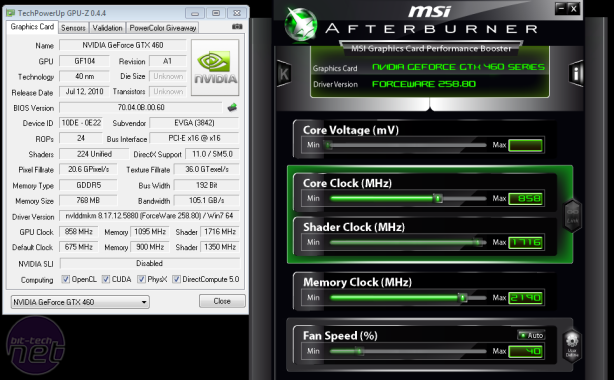
GeForce GTX 460 768MB Overclocking
The cheaper of the two GTX 460s is the 768MB version, which has a 192-bit memory interface rather than the 256-bit of the GTX 460 1GB. This means that there are fewer active memory controller units in the GTX 460 768MB GPU; the fewer the sub-units in a chip, the less to flake out when overclocking, so we expected the GTX 460 768MB to overclock further than the 1GB version. That said, the greater amount of memory (quite a few games want to use 1GB) and fatter memory interface of the 1GB version might still give it the edge over even an overclocked GTX 460 768MB. We were therefore looking forward to a session in the labs to see what would happen.By incrementally increasing the clock speed of the GPU and memory we found the maximum stable speeds of our EVGA card. The results were mind-boggling.
Our GTX 460 768MB was insanely overclockable, with extremely high frequencies easily attainable. Our final GPU overclock took it from 675MHz to 858MHz, with the stream processors therefore overclocked from 1,350MHz to 1,716MHz. This is a huge overclock - 27 per cent. While not every card will hit these lofty heights, manufacturers have already started releasing cards with clock speeds as high as 800MHz - this bodes well for the general level of overclockability in the GTX 460.
The GDDR5 memory was also very overclockable. Unlike system memory, graphics memory can make a large difference to game performance - the overclock from 900MHz (3.6GHz effective) to 1,095MHz (4.38GHz effective) represents a relative large 22 per cent boost, and netted us a healthy increase in performance.

It was relatively easy to hit this massive 20-odd per cent overclock with the GTX 460 768MB card. Click to enlarge
Most graphics card overclocks give only small increases in performance, which meant we expected more of the same with the GTX 460. However, we were taken aback when we saw the results - the overclocked GTX 460 768MB was significantly faster than at stock speeds. The minimum frame rate increased by 4fps to 19fps while the average increased by 6fps to 32fps at 1,680 x 1,050. Not only did this mean that the GTX 460 powered past its 1GB namesake, but it also outpaced the considerably more expensive, £270 GeForce GTX 470.
What was more impressive was that the GPU temperature was extremely low with this overclock applied. The card peaked at a delta T 40oC, which is much lower than other cards in the same price range. Furthermore, whilst the fan was almost at full speed (according to GPU-Z), it was reasonably quiet and was barely louder than our CPU cooler.
Conclusion
Overclocking the GTX 460 768MB proved very fruitful, with a large jump in performance that made our £175 EVGA card faster than a £270 GTX 470. The overclock was straightforward to apply – MSI’s Afterburner worked flawlessly, and by using Crysis we could stress both the GPU and memory and problem-spot failed overclocks quickly.However, the best result from our testing was that the maximum overclock can probably be run every day – it’s not just a theoretical maximum that we hit with the use of many case fans and a set of noise-mufflers to protect our ears. The fan remained quiet despite the overclock and the GPU didn’t heat up much either. That many manufacturers have started shipping GTX 460s with a core frequency of 800MHz or more indicates that our sample card is indicative of how overclockable GTX 460s are, rather than ours just being freakishly good. If you've got yourself a GTX 460 card by now, it would be criminal not to overclock it.

MSI MPG Velox 100R Chassis Review
October 14 2021 | 15:04








Want to comment? Please log in.